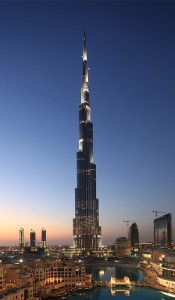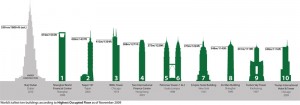Yesterday (2010-01-04), the Burj Dubai … recently renamed the Burj Khalifa, in honour of Abu Dhabi’s Ruler … was inaugurated. Dubayy, as it is known locally, is situated in the United Arab Emirates (UAE). Contrary to most reports, this building has a height of approximately 550 metres !

Every single metre counts in the race of the ‘tallest’ ! So, the timing of the following CTBUH(USA) Press Announcement, back in November 2009, was most fortunate. In my opinion, the most meaningful height criterion is … Height to Occupied Floor. But, what do you think ? See below.
However … purposefully tripping you up as you race to read all about the height criteria of Tall and Super-Tall Buildings … we should all know and understand, I hope, that comparing the ‘size’ of structural members is a silly schoolboy’s game. So, I would like to pose Some Important Questions (discussed, ad nauseam, in previous posts) about the Burj Khalifa Tower …
- Dubayy (Dubai) is a crude reproduction of the nightmare that is the 20th Century North American City, i.e. it is on the opposite end of the scale from being ‘sustainable’ ! ‘Greenwashing’ aside … How Sustainable is the Burj Khalifa Tower ?
- There is no effective system, in Dubayy, of Independent Monitoring and Technical Control of the processes of building design and construction by Local Authorities Having Jurisdiction (AHJ’s) or Competent Technical Controllers …
How Fire Safe is the Burj Khalifa Tower … for All of the large population, including People with Activity Limitations (2001 WHO ICF), who will undoubtedly be using/occupying the building during its long life cycle ?
Has the Tower been designed to adequately resist Fire-Induced Progressive Collapse ? ‘Robustness’ and ‘Disproportionate Damage’ are separate, but related, structural concepts.
During my next visit to Dubayy … I will enjoy looking at, and photographing, the completed building. But, I will not be entering the Burj Khalifa Tower !
.
Chicago, 2009-11-17: The Council on Tall Buildings & Urban Habitat (CTBUH) – the international body which arbitrates on tall building height and determines the title of ‘The World’s Tallest Building’ – has announced a change to its height criteria, as a reflection of recent developments with several super-tall buildings.
The new criteria wording – ‘Height is measured from the level of the lowest, significant, open air, pedestrian entrance to …’ allows for the recognition of the increasing numbers of multi-use tall buildings with often several different entrances at different levels, whilst also accommodating buildings constructed in non-traditional urban or suburban locations. The CTBUH Height Committee has determined that the previous description of where to measure tall building height from – ‘Height is measured from the sidewalk outside the main entrance to …’ is now no longer sufficient.
This will have an impact on both the height of tall buildings and their relative international height rankings. Burj Dubai, set to open as the world’s tallest building in January 2010, will now be measured from the lowest of its three main entrances (which opens into the entrance lobby for the tower’s corporate suite office function), while the recently completed Trump International Hotel & Towers in Chicago will be measured from the lower, publicly accessible Chicago Riverwalk. In the case of Trump, this additional 9 metres (approx.) means that it will surpass the Jin Mao Tower in Shanghai to occupy the rank of 6th tallest on the current list of completed buildings.
“Beginning in 2007, with the knowledge that Burj Dubai would be significantly taller than any structure ever built, the CTBUH Height Committee met to review the criteria by which we recognize and rank the height of buildings”, said Peter Weismantle, Chair of the CTBUH Height Committee and Director of Supertall Building Technology at Adrian Smith + Gordon Gill Architecture in Chicago. “As one might guess, with the committee being made up of architects, engineers, contractors, developers, building owners and academics, a variety of opinions and views were expressed. The resulting revisions, almost two years later, reflect a general consensus of the committee in recognizing the most recent trends in tall building development around the world.”
Also in response to the changing designs and forms of tall buildings, the Height Committee has elected to discard its previous ‘Height to Roof’ Category. “The roof category just doesn’t make sense anymore”, said CTBUH Executive Director Antony Wood. “In the era of the flat-topped modernist tower, a clearly defined roof could usually be identified, but in today’s tall building world – which is increasingly adopting elaborate forms, spires, parapets and other features at the top of the building – it is becoming difficult to determine a ‘roof’ at all, even less so to measure to it.”

The Revised CTBUH Height Criteria and Diagrams of the Tallest 10 Buildings in the World as of November 2009 can be found here, ranked according to the three height categories now recognized by CTBUH. These are: (i) Height to Architectural Top, measured to the topmost architectural feature of the building including spires, but not including antennae, signage, flag poles or other functional-technical equipment; (ii) Height to Highest Occupied Floor, measured to the level of the highest, consistently occupied floor in the building (thus not including service or mechanical areas which experience occasional maintenance access); and (iii) Height to Tip, measured to the highest point of the building, irrespective of material or function of the highest element.
.
.
END
